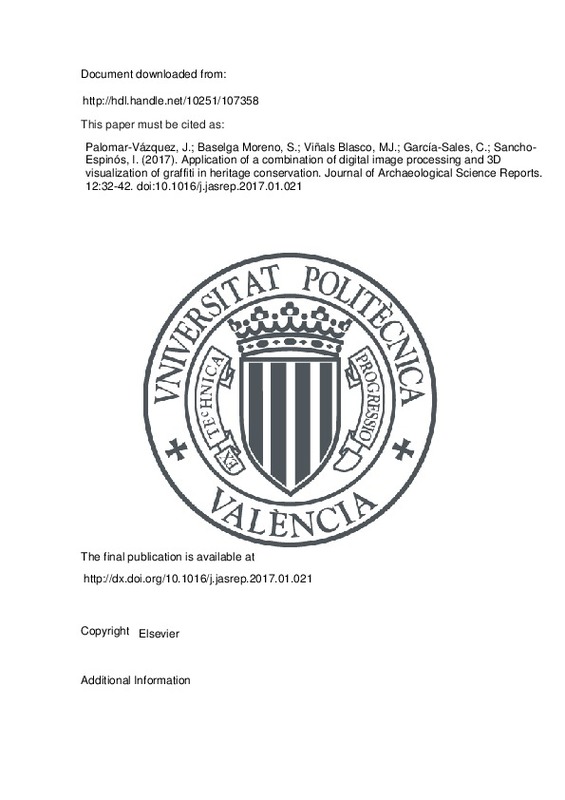JavaScript is disabled for your browser. Some features of this site may not work without it.
Buscar en RiuNet
Listar
Mi cuenta
Estadísticas
Ayuda RiuNet
Admin. UPV
Application of a combination of digital image processing and 3D visualization of graffiti in heritage conservation
Mostrar el registro sencillo del ítem
Ficheros en el ítem
| dc.contributor.author | Palomar-Vázquez, Jesús
|
es_ES |
| dc.contributor.author | Baselga Moreno, Sergio
|
es_ES |
| dc.contributor.author | Viñals Blasco, Mª José
|
es_ES |
| dc.contributor.author | García-Sales, Carles
|
es_ES |
| dc.contributor.author | Sancho-Espinós, Ignacio
|
es_ES |
| dc.date.accessioned | 2018-09-17T07:09:02Z | |
| dc.date.available | 2018-09-17T07:09:02Z | |
| dc.date.issued | 2017 | es_ES |
| dc.identifier.issn | 2352-409X | es_ES |
| dc.identifier.uri | http://hdl.handle.net/10251/107358 | |
| dc.description.abstract | [EN] In recent years, heritage documentation processes have largely benefited from the application of both 2D imagery analysis and 3D techniques for recording and visualization of assets. In this paper, a combined 2D-3D methodological workflow, especially helpful for the documentation of graffiti on closed and narrow spaces, is presented. It is proposed, firstly, the use of structure from motion software to obtain the 3D model and texture information. Then, the use of decorrelation stretching algorithms is used to obtain enhanced textures. This study found that the performance of the algorithms usually recommended for enhancement of the different colours is sometimes suboptimal. Finally, the integration of 2D and 3D information into Blender, a powerful 3D open-source tool, allows for a detailed exploration of the areas containing graffiti. Additionally, it allows high quality rendition of the resulting model that helps to better understand and record heritage resources. This methodological approach has been applied to the military defense heritage site of Puig-Carassols trench line in Spain. | es_ES |
| dc.language | Inglés | es_ES |
| dc.publisher | Elsevier | es_ES |
| dc.relation.ispartof | Journal of Archaeological Science Reports | es_ES |
| dc.rights | Reconocimiento - No comercial - Sin obra derivada (by-nc-nd) | es_ES |
| dc.subject | Image enhancement | es_ES |
| dc.subject | 3D modeling | es_ES |
| dc.subject | Heritage documentation | es_ES |
| dc.subject | Decorrelation stretching | es_ES |
| dc.subject | Blender | es_ES |
| dc.subject.classification | INGENIERIA CARTOGRAFICA, GEODESIA Y FOTOGRAMETRIA | es_ES |
| dc.subject.classification | GEOGRAFIA FISICA | es_ES |
| dc.title | Application of a combination of digital image processing and 3D visualization of graffiti in heritage conservation | es_ES |
| dc.type | Artículo | es_ES |
| dc.identifier.doi | 10.1016/j.jasrep.2017.01.021 | es_ES |
| dc.rights.accessRights | Abierto | es_ES |
| dc.date.embargoEndDate | 2019-04-01 | es_ES |
| dc.contributor.affiliation | Universitat Politècnica de València. Departamento de Ingeniería Cartográfica Geodesia y Fotogrametría - Departament d'Enginyeria Cartogràfica, Geodèsia i Fotogrametria | es_ES |
| dc.description.bibliographicCitation | Palomar-Vázquez, J.; Baselga Moreno, S.; Viñals Blasco, MJ.; García-Sales, C.; Sancho-Espinós, I. (2017). Application of a combination of digital image processing and 3D visualization of graffiti in heritage conservation. Journal of Archaeological Science Reports. 12:32-42. doi:10.1016/j.jasrep.2017.01.021 | es_ES |
| dc.description.accrualMethod | S | es_ES |
| dc.relation.publisherversion | http://dx.doi.org/10.1016/j.jasrep.2017.01.021 | es_ES |
| dc.description.upvformatpinicio | 32 | es_ES |
| dc.description.upvformatpfin | 42 | es_ES |
| dc.type.version | info:eu-repo/semantics/publishedVersion | es_ES |
| dc.description.volume | 12 | es_ES |
| dc.relation.pasarela | S\324636 | es_ES |







![[Cerrado]](/themes/UPV/images/candado.png)

